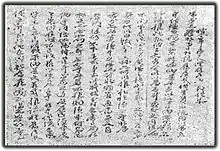Jaegaseung
Jaegaseung (Korean: 재가승, Japanese: 在家僧) were descendants of Jurchen people who lived in Korea. They formed villages of married lay monks.[2] They produced oatmeal paper and paid their taxes with it.[3]
재가승 | |
|---|---|
| Total population | |
| 1,031 households[1] (1957) | |
| Regions with significant populations | |
| Northeastern Korea | |
| Languages | |
| Yukjin dialect | |
| Religion | |
| Buddhism | |
| Related ethnic groups | |
| Jurchen, Koreans |


Monastic identity of the lay monks was seen as antisocialist, and the villages have ceased to exist.[2]
Buddhist communities have been repressed by communist governments in Asian countries. The local communities had survived through colonial period without serious pressure from outside.[4]
Origins and history
The mountains of northern Hamgyŏng Province were traditionally inhabited by the Jurchens, a semi-nomadic Tungusic people. In the mid-fifteenth century, King Sejong conquered the region as far north as the Tumen River, which even today marks Korea's northern border, and established Korean colonies in the area. Many Jurchens accepted Korean hegemony and played crucial roles in frontier defense against other Jurchen tribes more hostile to Korean presence.[5] By the sixteenth century, the Jurchens living under Korean rule were often married to ethnic Koreans and had become increasingly agricultural. They were also economically and militarily linked to the central Korean state. At the same time, they retained close contacts with independent Jurchens across the Tumen.[6]
By the late sixteenth century, however, conflicts over land between indigenous Jurchens and Korean settlers were increasingly frequent. The Jurchen chieftain Nitanggae rebelled in 1583, severely undermining the Korean state's control of the area. The crisis was exacerbated by the large-scale Japanese invasion in 1592 during which Katō Kiyomasa conquered large parts of Hamgyŏng, leading to a breakdown of the Korean administration and major conflicts between Jurchens and Koreans.[7]
Beginning in around 1590, independent Jurchen chieftains such as Nurhaci and Bujantai were competing for hegemony over their cousins in Korean territory. Having routed Bujantai in 1607, Nurhaci successfully removed most Jurchens in northern Hamgyŏng into his newfound kingdom north of the Tumen between 1607 and 1609. Nurhaci's Jurchens would eventually adopt a new Manchu identity in 1635 and go on to conquer China, founding China's final imperial dynasty.[8] Nurhaci and his successors continued to demand the forcible "repatriation" of Jurchens in Korea until 1644, although some Jurchens successfully evaded deportation and remained in Korea with the support of sympathetic Korean authorities.[9]
It is generally agreed that the Jaegaseung were descendants of these Jurchen communities who avoided capture, assimilated into Korean society.[2]
Culture
Jaegaseung girls and women were notorious in mainstream Korean society for always exposing their breasts even in public, which was considered scandalous by other Koreans.[10]
References
- Hwang 2016, p. 82.
- Kim Hwansoo (2013). "'The Mystery of the Century:' Lay Buddhist Monk Villages (Chaegasŭngch'on) Near Korea's Northernmost Border, 1600s–1960" (PDF). Seoul Journal of Korean Studies. 26 (2): 297–299. doi:10.1353/seo.2013.0019. S2CID 201783375. Retrieved April 24, 2016.
- Dong-A ilbo, January 1, 1936, 51st page
- Frank Reynolds; Jason A. Carbine (2000). The Life of Buddhism. University of California Press. p. 16. ISBN 978-0-520-21105-6.
- Bohnet 2008, p. 114.
- Bohnet 2008, p. 115.
- Bohnet 2008, pp. 115–116.
- Bohnet 2008, pp. 117–120.
- Bohnet 2008, pp. 120–122.
- Hwang 2016, p. 139.
Works cited
- Bohnet, Adam (2008). "'On Either Side the River': The Rise of the Manchu State and Chosŏn's Jurchen Subjects". Toronto Studies in Central and Inner Asia. 9: 111–125.
- 황철산 (Hwang Cheol-san) (2016). Joo Kang-hyun (ed.). Hwang Cheol-san Minsokhak 황철산 민속학 [Ethnography of Hwang Cheol-san]. Minsogwon. ISBN 978-89-285-0958-4; anthology of 1950s works by a North Korean ethnographer
Further reading
| Wikimedia Commons has media related to Jaegaseung people. |
- Hwang Chol-san (1960). Hamgyŏng pukto pukpu san'gan purak (chaegasŭng purak) ŭi munhwa wa p'ungsŭp [Culture and customs of the mountain villages (lay monk villages) in far northern Hamgyong province]. OCLC 23977624.
- Kim Hwansoo (2013). "'The Mystery of the Century:' Lay Buddhist Monk Villages (Chaegasŭngch'on) Near Korea's Northernmost Border, 1600s–1960" (PDF). Seoul Journal of Korean Studies. 26 (2): 269–305. doi:10.1353/seo.2013.0019. S2CID 201783375. Retrieved April 24, 2016.